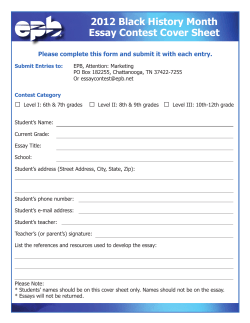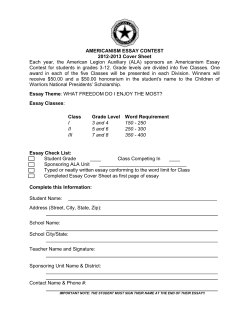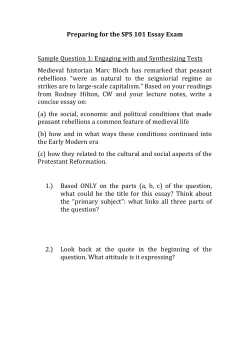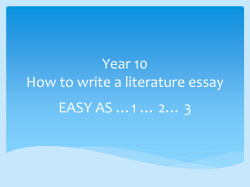
AP World History : Sample Syllabus 1 Syllabus Number: 876072v1
AP World History : Sample Syllabus 1 Syllabus Number: 876072v1 Course Text and other Reading: Main Text: Bentley and Ziegler. 2010. Traditions and Encounters, 5th ed. United States: McGraw-Hill. [CR1a] CR1a: The course includes a collegelevel world history textbook. Primary Sources: • S tudents will read and analyze selected primary sources (documents, images, and maps) in »» Andrea, A. and Overfield, J. 2000. The Human Record: Sources of Global History, vols I & II. Houghton Mifflin College Division. and »» Spodek. 2000. The World’s History, 2nd edition. Prentice-Hall. • Students will analyze quantitative sources through study and interpretation of graphs, charts and tables »» Stearns. 2008. World Civilizations: The Global Experience. Pearson. »» from Document Based Questions released by the College Board Secondary Sources [CR1c] • • • • • McNeill, J.R. and McNeill, W. H. 2003. The Human Web. Norton & Co. Pomeranz, K. and Topik, S. 1999. The World that Trade Created. M.E. Sharpe. Friedel, D. and Schele, L. 1991. A Forest of Kings. Quill. Pomeranz, K. 2000. The Great Divergence. Princeton. and Goldstone, J. 2008. Why Europe? The Rise of the West in World History. McGraw Hill. CR1c: The course includes sources written by historians or scholars interpreting the past. Themes and AP World History: Students in this course must learn to view history thematically. The AP World History course is organized around five overarching themes that serve as unifying threads throughout the course, helping students to relate what is particular about each time period or society to a “big picture” of history. The themes also provide a way to organize comparisons and analyze change and continuity over time. Consequently, virtually all study of history in this class will be tied back to these themes by utilizing a “SPICE” acronym. [CR2] Social--Development and transformation of social structures • • • • Gender roles and relations Family and kinship Racial and ethnic constructions Social and economic classes CR2: Each of the course themes receives explicit attention and is addressed throughout the course. – Course themes Political--State-building, expansion, and conflict • • • • • Political structures and forms of governance Empires Nations and nationalism Revolts and revolutions Regional, trans-regional, and global structures and organizations Sample Syllabus 1 AP World History : Sample Syllabus 1 Interaction between humans and the environment • • • • Demography and disease Migration Patterns of settlement Technology CR3: Each of the key concepts receives explicit attention in the relevant historical period and is integrated with the course themes. – Key concepts Cultural--Development and interaction of cultures • • • • Religions Belief systems, philosophies, and ideologies Science and technology The arts and architecture Economic--Creation, expansion, and interaction of economic systems • • • • • Agricultural and pastoral production Trade and commerce Labor systems Industrialization Capitalism and socialism CR5a: The course provides balanced global coverage, with Africa represented. CR5d: The course provides balanced global coverage, with Oceania and Australia represented. Course Schedule Unit 1 To 600 BCE: Technological and Environmental Transformations Key Concepts: [CR3] • Big Geography and the Peopling of the Earth • Neolithic Revolution and Early Agricultural Societies • Development and Interactions of Early Agricultural, Pastoral, and Urban Societies Topics for Overview include: • Prehistoric Societies • From Foraging to Agricultural and Pastoral Societies • Early Civilizations: Middle East, South Asia, East Asia, the Americas, Africa, and Oceania Special Focus: Issues Regarding the Use of the Concept of Civilization Activities & Skill Development • S tudents will identify and analyze the causes and consequences of the Neolithic Revolution in the major river valleys as well as in Sub-Saharan Africa and Papua New Guinea [CR5a], & [CR5d] • Class Discussion »» How were gender roles changed by the Neolithic Revolution? • Collaborative Group-Jigsaw »» Students will analyze how geography affected the development of political, social, economic, and belief systems in the earliest civilizations in: Mesopotamia Egypt 2 AP World History : Sample Syllabus 1 South Asia East Asia [CR5c] Mesoamerica [CR5b] Andes Each group will examine a different civilization then compare findings with a new group where each student examined a different civilization. • Parallel Reading--Students will read Ch. 1-2 of The Human Web and »» evaluate the authors’ perspective on the existence of a very loose knit global web during this early period [CR7] Unit 2 600 BCE-600 CE: Organization and Reorganization of Human Societies Key Concepts: [CR3] • Development and Codification of Religious and Cultural Traditions • Development of States and Empires • Emergence of Transregional Networks of Communication and Exchange Topics for Overview include: • Classical Civilizations • Major Belief Systems: Religion and Philosophy • Early Trading Networks Special Focus: • World Religions »» Animism focusing on Australasia and Sub-Saharan Africa »» Judaism and Christianity »» Hinduism and Buddhism »» Daoism and Confucianism • Developments in Mesoamerica and Andean South America: Moche and Maya »» Bantu Migration and its Impact in Sub-Saharan Africa »» Transregional Trade: the Silk Road and the Indian Ocean »» Developments in China—development of imperial structure and Confucian society Activities & Skill Development: • W riting a Comparison Essay [CR12] Methods of political control in the Classical period, student choice of two Han China, Mauryan/Gupta India, Imperial Rome, Persian Empire • Writing a Change and Continuity over Time Essay [CR10] Political and Cultural Changes in the Late Classical Period, students choose China, India, or Rome • Students will evaluate the causes and consequences of the decline of the Han, Roman, and Gupta empires [CR9] • Students will map the changes and continuities in long-distance trade networks in the Eastern Hemisphere: Eurasian Silk Roads, Trans-Saharan caravan routes, Indian Ocean sea lanes, and Mediterranean sea lanes • Group Presentations CR5c: The course provides balanced global coverage, with Asia represented CR5b: The course provides balanced global coverage, with the Americas represented. CR7: The course provides opportunities for students to identify and evaluate diverse historical interpretations. – Interpretation CR3: Each of the key concepts receives explicit attention in the relevant historical period and is integrated with the course themes. – Key concepts CR12: The course provides opportunities for students to compare historical developments across or within societies in various chronological and/ or geographical contexts. – Comparison CR10: The course provides opportunities for students to identify and analyze patterns of continuity and change over time and across geographic regions, relating these patterns to a global context. – Patterns of change and continuity over time CR9: The course provides opportunities for students to examine relationships between causes and consequences of events or processes. – Historical causation 3 AP World History : Sample Syllabus 1 Each group will research and present a major world religion/belief system examining: »» origin »» beliefs and practices »» diffusion • After reading excerpts from A Forest of Kings by David Friedel and Linda Schele and seeing the PBS Nova program “Cracking the Maya Code,” students will assess the impact that archaeology and iconography have had on the study of history [CR7] & [CR15] • Parallel Reading--Students will read Ch. 3 of The Human Web and »» Trace the development of civilization in each region utilizing a linear thematic organizer for note-taking and a circular organizer for the big picture »» evaluate the periodization in Ch.3—i.e. the use of 200 CE as a break as opposed to the periodization of the course curriculum [CR11] Unit 3 600-1450: Regional and Transregional Interactions Key Concepts: • Expansion and Intensification of Communication and Exchange Networks • Continuity and Innovation of State Forms and Their Interactions • Increased Economic Productive Capacity and Its Consequences Topics for Overview include: • • • • • • • • • • Byzantine Empire, Dar-al Islam, & Germanic Europe Crusades Sui, Tang, Song, and Ming empires Delhi Sultanate The Americas The Turkish Empires Italian city-states Kingdoms & Empires in Africa The Mongol Khanates Trading Networks in the Post-Classical World Special Focus: • • • • Islam and the establishment of empire Polynesian Migrations Empires in the Americas: Aztecs and Inca Expansion of Trade in the Indian Ocean—the Swahili Coast of East Africa Activities & Skill Development: • Writing a Comparison Essay »» Comparing the level of technological achievement including production of goods 500-1000 [CR4] • Student choice: Middle East, South Asia, East Asia, Eastern Europe • Students will evaluate the causes and consequences of the spread of Islamic empires [CR4] • Students will compare the Polynesian and Viking migrations [CR4] CR7: The course provides opportunities for students to identify and evaluate diverse historical interpretations. – Interpretation CR15: The course provides opportunities for students to recognize how the study of history has been shaped by the findings and methods of other disciplines such as anthropology, archaeology, visual arts, literature, economics, geography and political science. – Synthesis CR11: The course provides opportunities for students to examine diverse models of periodization constructed by historians. – Periodization CR4: The course provides opportunities for students to demonstrate command of course themes and key concepts through activities and assignments where students use their knowledge of detailed and specific relevant historical developments and processes – including names, chronology, facts and events. 4 AP World History : Sample Syllabus 1 • Writing a Comparison Essay »» Effects of Mongol conquest and rule, students choose two: Russia, China, Middle East • Class Debates »» Topic—Were the economic causes of the voyages of the Ming navy in the first half of the 15th century the main reason for their limited use? »» Topic—Were the tributary and labor obligations in the Aztec and Inca empires more effective than similar obligations in the Eastern Hemisphere? [CR4] • Writing a Change and Continuity over Time Essay »» Changes and Continuities in patterns of interactions along the Silk Roads 200 BCE1450 CE [CR4] • Parallel Reading--Students will read Ch. 4 & 5 of The Human Web and »» Trace the development of civilization in each region utilizing a linear thematic organizer for note-taking and a circular organizer for the big picture »» evaluate the periodization in the book compared to that of the periodization in the course curriculum Why 200-1000 CE and 1000-1500 CE instead of 600-1450? In what regions does each work best? Why? In what areas does each present a problem? Why? [CR11] Unit 4: 1450-1750: Global Interactions Key Concepts: • Globalizing Networks of Communication and Exchange • New Forms of Social Organization and Modes of Production • State Consolidation and Imperial Expansion Topics for Overview include: Bringing the Eastern and Western Hemispheres Together into One Web • Ming and Qing Rule in China • Japanese Shogunates • The Trading Networks of the Indian Ocean • Effects of the Continued Spread of Belief Systems Special Focus: • • • • Three Islamic Empires: Ottoman, Safavid, Mughal Cross-Cultural Interaction: the Columbian Exchange The Atlantic Slave Trade Changes in Western Europe—roots of the “Rise of the West” [CR5e] Activities & Skill Development • S tudents will evaluate the causes and consequences of European maritime expansion including the development of armed trade using guns and cannons • student project »» Each student will apply techniques used by art historians to examine visual displays of power in one of the land or sea based empires that developed in this time period [CR15] • Writing a Comparison Essay CR4: The course provides opportunities for students to demonstrate command of course themes and key concepts through activities and assignments where students use their knowledge of detailed and specific relevant historical developments and processes – including names, chronology, facts and events. CR11: The course provides opportunities for students to examine diverse models of periodization constructed by historians. – Periodization CR5e: The course provides balanced global coverage with Europe represented. No more than 20% of course time is devoted to European History. CR15: The course provides opportunities for students to recognize how the study of history has been shaped by the findings and methods of other disciplines such as anthropology, archaeology, visual arts, literature, economics, geography and political science. – Synthesis 5 AP World History : Sample Syllabus 1 »» Processes of empire building, students compare Spanish Empire to either the Ottoman or Russian empires • Writing a Change and Continuity over Time Essay »» Changes and Continuities in trade and commerce in the Indian Ocean Basin 6001750 • Parallel Reading--Students will read Ch. 6 of The Human Web and »» Trace the development of civilization in each region utilizing a linear thematic organizer for note-taking and a circular organizer for the big picture »» Consider the question of periodization: 1750 or 1800? Unit 5 1750-1900: Industrialization and Global Integration Key Concepts: • • • • Industrialization and Global Capitalism Imperialism and Nation-State Formation Nationalism, Revolution and Reform Global Migration Topics for Overview include: • The Age of Revolutions: »» English Revolutions, Scientific Revolution & Enlightenment, »» American Revolution, French Revolution and its fallout in Europe, Haitian & »» Latin American Revolutions • Global Transformations: »» Demographic Changes, the End of the Atlantic Slave Trade, Industrial Revolution and Its Impact, Rise of Nationalism, Imperialism and its Impact on the World Special Focus: • • • • Decline of Imperial China and the Rise of Imperial Japan 19th Century Imperialism: Sub-Saharan Africa, South and Southeast Asia Comparing the French and Latin American Revolutions Changes in Production in Europe and the Global Impact of those Changes [CR5e] Activities include: • Writing a Comparison Essay »» Comparing the roles of Women from 1750 to 1900—East Asia, Western Europe, South Asia, Middle East [CR4] • Students will write a change and continuity over time essay evaluating changes in production of goods from 1000 to 1900 in the Eastern Hemisphere • Parallel Reading--Students will read Ch. 7 of The Human Web and »» Trace the development of civilization in each region utilizing a linear thematic organizer for note-taking and a circular organizer for the big picture »» Consider the question of periodization: 1900 or 1914? • Students will analyze five political cartoons about European imperial expansion in Asia and Africa to identify how nationalism and the Industrial Revolution served as motivating factors in empire building in this time period [CR1b] & [CR8] • Students will analyze tables showing increased urbanization in various parts of the CR5e: The course provides balanced global coverage with Europe represented. No more than 20% of course time is devoted to European History. CR4: The course provides opportunities for students to demonstrate command of course themes and key concepts through activities and assignments where students use their knowledge of detailed and specific relevant historical developments and processes – including names, chronology, facts and events. CR1b: The course includes diverse primary sources, including written documents, maps, images, quantitative data (charts, graphs, tables), works of art, and other types of sources. CR8: The course provides opportunities for students to analyze evidence about the past from diverse sources, including written documents, maps, images, quantitative data (charts, graphs, tables), works of art, and other types of sources. – Appropriate use of historical evidence 6 AP World History : Sample Syllabus 1 world to consider connections between urbanization and industrialization.[CR1b] & [CR8] • Students will identify and evaluate diverse historical interpretations regarding the rise of the West utilizing Kenneth Pomeranz’s The Great Divergence (Princeton, 2000) and Jack Goldstone’s Why Europe? The Rise of the West in World History (McGraw Hill, 2008) • Utilizing a series of documents, maps and charts in the released DBQ about indentured servitude on in the 19th and 20th centuries, students will assess the connections between abolition of plantation slavery and increased migrations from Asian countries to the Americas [CR13] Unit 6 1900-present: Accelerating Global Change and Realignments Key Concepts: • Science and the Environment • Global Conflicts and Their Consequences • New Conceptualizations of Global Economy and Culture Topics for Overview include: • Crisis and Conflict in the Early 20th Century: »» Anti-Imperial Movements, World War I, Russian, Chinese and Mexican Revolutions, Depression, Rise of Militaristic and Fascist Societies, World War II • Internationalization: »» Decolonization, the Cold War World, International Organizations, the Post-Cold War World, Globalization Special Focus: • World War I and World War II: Global Causes and Consequences • Activity—Skill Development »» Students will identify and analyze the causes and consequences of the global economic crisis in the 1930s • Development of Communism in China, Russia, and Cuba • Responses to Western Involvement in Sub-Saharan Africa: Imperialism, the Cold War, and International Organizations CR1b: The course includes diverse primary sources, including written documents, maps, images, quantitative data (charts, graphs, tables), works of art, and other types of sources. CR8: The course provides opportunities for students to analyze evidence about the past from diverse sources, including written documents, maps, images, quantitative data (charts, graphs, tables), works of art, and other types of sources. – Appropriate use of historical evidence CR13: The course provides opportunities for students to connect historical developments to specific circumstances of time and place, and to broader regional, national, or global processes. – Contextualization Activities include: • W riting a Comparison Essay Comparing the political goals and social effects of revolution in: China, Russia, Mexico: Students choose two • Writing a Change and Continuity over Time Essay: Changes and Continuities in the formation of national identities 1900-present. Students choose from among the following regions: Middle East, South Asia, or Latin America • Students debate the benefits and negative consequences of the rapid advances in science during the 20th and early 21st centuries • Students trace the development of one form of popular culture in the 20th century and present a graphic or visual display of their research to the class • Parallel Reading--Students will read Ch.8 of The Human Web and »» Consider the following: Why does this chapter reach back to 1890? 7 AP World History : Sample Syllabus 1 Essay Writing Throughout the course students will be required to write essays in class demonstrating their mastery of content as well as their ability to develop coherent written arguments that have a thesis supported by relevant historical evidence. During first semester the focus will be on the development of essay writing skills via time spent on essay writing workshops utilizing the following format in essay development: Introductory Paragraph—3 to 4 sentences, ending with thesis statement Thesis Statement-what does it need to include? • time period • region(s) • the answer to the prompt CR8: The course provides opportunities for students to analyze evidence about the past from diverse sources, including written documents, maps, images, quantitative data (charts, graphs, tables), works of art, and other types of sources. – Appropriate use of historical evidence Organization of Body Paragraphs— • • • • • • • • • Topic Sentence—this can be general since the thesis contains specificity General Assertion—identifies one aspect of thesis (i.e. a change, a difference, etc.) Support/evidence/examples—Be specific! Analysis-explain cause and/or effect General Assertion—identifies one aspect of thesis (i.e. a change, a difference, etc.) Support/evidence/examples—Be specific! Analysis-explain cause and/or effect Repeat format as necessary Concluding Sentence Concluding Paragraph • 3-4 sentences • Start by restating (a rephrased) thesis in its entirety Essay writing workshops will include group discussion utilizing example essay, selfevaluation, and peer evaluation Primary Source Document Notebook Assignment Throughout the first semester students will have the opportunity to develop and enhance their skills at interpreting, summarizing, and analyzing primary source material including documents, maps, charts & graphs, and visuals. The ability to comprehend and analyze primary sources will first be practiced in large group and small group discussion then in individual primary source assignments that students will summarize and analyze and place in a Primary Source Notebook which will be turned in once each 6-week grading period. Directions for Primary Source Write-ups: [CR8] READ the document or STUDY the data or visual. Then write a summary (the MAIN point or points) of the document. This summary should be brief paragraph and should highlight the main gist of the source in the students own words. The analysis of the source will be contained in a separate paragraph and should include: • Historical Context--where the source fits in the framework of history. • AP themes that the source addresses. Students will be required to identify where and explain how the source addresses that theme. Students will identify as many themes as 8 AP World History : Sample Syllabus 1 they can find but then evaluate those themes and only include what they consider to be the two most prominent themes. »» Point of View—here students must consider »» point of view of the author, »» the type of document and/or tone of the source »» purpose and/or intended audience This skill will be developed throughout much of first semester using class discussion and partner discussions with the end goal that all students will understand how to analyze the overall point of view of a source and be able to discuss how that point of view may affect the source by the end of first semester. Some of the sources used for these exercises include: [CR1b] • • • • • • • • • • • • • • • • • • • • • Tacitus from Germania Female figure from Catalhuyuk (visual) Graph—world population 3000 BCE -1500 CE The Code of Hammurabi “Be a Scribe” The Writings of Han Fei Asoka, Rock and Pillar Edicts Pericles Funeral Oration Shi Huangdi’s Terracotta Army (visual) Fu Xuan, How Sad it is to be a Woman Live, History of Rome Procopius from On the Buildings and The Secret History Shield Jaguar and lady Xoc: A Royal Couple of Yaxchilan (visual) Xuanzang, Record of the Western Region Einhard, The Life of Charlemagne Ibn Battuta, Travels in Asia and Africa Kitabatake Chikafusa, The Chronicle of the Direct Descent of Gods and Sovereigns The Chronicle of Novgorod William of Rubruck, Journey to the Land of the Mongols World Population Growth 1000-2000 (graph) Jahangir, Memoirs CR1b: The course includes diverse primary sources, including written documents, maps, images, quantitative data (charts, graphs, tables), works of art, and other types of sources. CR6: The course provides opportunities for students to develop coherent written arguments that have a thesis supported by relevant historical evidence. – Historical argumentation CR14: The course provides opportunities for students to apply multiple historical thinking skills to examine a particular historical problem or question and connect insights from one historical context to another, including the present. – Synthesis Students will continue to practice their skills at interpreting and analyzing primary sources by using them to synthesize information in DBQ essays. After introducing the concept of the DBQ to the students via roundtable discussion and practice writing of thesis statements and individual body paragraphs, students will write 4-6 DBQ essays that include written and visual sources as well as map, charts, and graphs. [CR6] & [CR14] 9
© Copyright 2025











